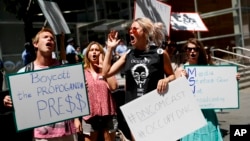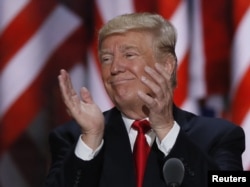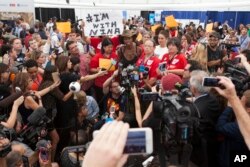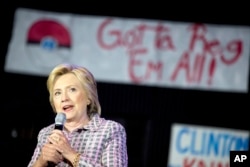If change is the watchword for the 2016 presidential election campaign – with one party nominating an outspoken businessman, the other flirting with a progressive outsider – the dynamic among U.S. news media, the political process and the audience is transforming as well.
With thousands of national and international reporters assembled to cover the Democratic National Convention, a group of journalists gathered Wednesday for a little soul searching only a few miles from the convention hall.
“I think there has been a massive failure in television news,” Campbell Brown, a former anchor for NBC News and CNN, said during a panel discussion on media. It was part of the International Leaders Forum, a week-long series organized around the convention.
She was among five journalists with national reputations discussing how their business covered the primary campaign season, and what that might portend for the general election in November.
Brown said journalists failed to ask tough questions of Republican presidential nominee Donald Trump early in the election cycle, giving his campaign millions of dollars in free publicity and boosting his candidacy in a crowded primary-season field. She argued there is financial incentive for the commercial media, because coverage of Trump resulted in higher ratings.
The panelists focused on national news media coverage of Trump, the brash New York developer whose campaign style differs radically from traditional politicians.
Separately, the Tyndall Report, which monitors U.S. network news, found candidate Trump dominated network news coverage in 2015, the latest aggregated report on the number of minutes devoted to presidential candidates.
The widely quoted study group found coverage of Trump accounted for almost a third of all news minutes in the three major TV networks (CBS, NBC and ABC) – more than all the Democratic candidates combined.
Moreover, the assembled journalists said cable news channels ran hours of Trump speaking at rallies, with little analysis of what the candidate was saying.
Changing media landscape
The changing nature of how Americans find and consume news has helped shape the political debate in this country, said Amy Mitchell, director of journalism research at the Pew Research Center. Pew’s survey found Americans receive news about the election from at least five or more sources. Almost a third of survey respondents said they turned directly to Trump's or rival Hillary Clinton’s social media account for information.
Two decades ago, there was no social media. Cable news was in its adolescence. Pew’s studies showed voters got their campaign information from media that was much different than today.
In 1991, 68 percent of Americans watched television news; by 2012, that number had dropped to 55 percent, Pew found.
The change is more dramatic for print media. In two decades, those who read a newspaper dropped from 56 percent to 29 percent.
The nonpartisan public opinion research center's first measurement of “online mobile news” came in 2002, when 24 percent of the U.S. public got some news in this manner. By 2012, the number was up to 39 percent.
The journalism panel in Philadelphia noted another change in the public’s news habits.
“Even though most Americans get most of their news from lots of places, there’s a propensity at the edges of ideological divides to get their news only from certain sources,” said Mitchell, pointing to the 2016 media landscape.
The increasing tendency toward polarization, combined with the fact that 59 percent of Americans say they are already worn out or exhausted by election coverage, sets the stakes even higher for news media and voters heading into November.
What is truth?
“You can normalize almost anything in this environment,” said Susan Glasser, editor of political journal POLITICO.
With the advent of social media and the removal of traditional media gatekeepers, the political conversation has changed in unpredictable ways.
The proliferation of news sources has broadened the conversation to “a whole new ecosystem of websites and online magazines,” Glasser said. “It’s not just one conservative outlet and one liberal outlet but a whole new way to extract information according to your partisan preferences.”
The ideological divide means even the news story itself is now up for debate. Both the Clinton and the Trump campaigns link to outside news stories on their websites as well as social media accounts to advance the campaigns' agendas. The more a campaign can shape a narrative, the harder it becomes for journalists to present objective truths, they said.
“People are angry and they don’t believe what they’re being told, even when they’re being told facts,” said Jonathan Capeheart, an opinion writer at The Washington Post.
Traditional media struggle to catch up with the demands of the 24-hour news cycle, now defined by a borderless conversation on social media. Especially in an election, said David Lauter, reporters and their readers are struggling to catch up with the constant flow of information as everyone tries to cover the same news story in a different way.
“Amid constant deadlines and the welter of things we do all the time, we need to keep our focus on producing stories that are of high quality and that are unique as much as possible,” said Lauter, Washington bureau chief for the Los Angeles Times and Chicago Tribune. He tries to address that by carving out time for his reporters to think in depth about the personalities and issues they cover.
And the pressures are certain to intensify as the election season moves on.
“We have some very serious challenges ahead of us as a country and as the press,” said Glasser.












